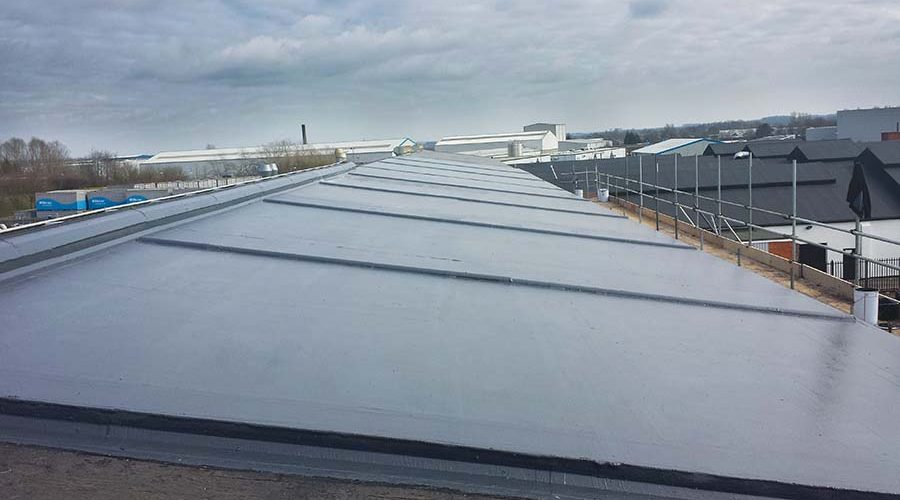Whether it’s social housing, a school, or surgery roofing; projects vary in size and scope. Yet, isn’t the need to specify high-performance, cost-effective materials a commonality for all? Unlike flat roofs made from traditional materials, which typically have a 10-year lifespan and are prone to damage and subsequent water ingress, glass-reinforced plastic (GRP) provides a cold-applied, weathertight, highly-durable seal for all manner of roofing structures of up to 20 years with little maintenance. With a seemingly endless number of benefits, including cost-effectiveness and ease of installation, flat roofing provider Stormking lists the top five benefits of GRP flat roofing for public sector projects.
Stormking
1. Ensures safety during installation
Flat roofs have been a popular method of construction for many years, and are traditionally made using materials such as bitumen. However, many schools and council offices
are now stipulating that they need to have flame-free installation when it comes to roofing in the form of cold-applied liquid solutions.
This move towards cold-applied systems has grown in demand as a result of unfortunate instances of fire. When applied to a concrete or timber roof, bitumen has to be activated by a flame. This then causes it to melt, so it can be subsequently rolled out onto a structure. Although it has been a method which has been used for a long period of time – and always undertaken whilst a building is uninhabited – the risk with bitumen is still, nonetheless, significant.
In a post-Grenfell industry, we should be seeking alternative materials which mitigate risk as much as possible. The Government has passed health and safety legislation to make public sector buildings have flame-free roofing solutions. Stormking has a fire-retardant GRP flat roof system which features as part of its StormDeck-GRP flat roof range. This system is a high-performance, built-up, cold-applied, liquid-applied flat roofing product comprising a GRP chopped strand mat, curing catalyst, polymer topcoat, as well as that all-important fire-retardant polyester resin.
With a cold works solution; therefore, the risk is completely reduced as no flame is needed. Furthermore, unlike hot works, a building doesn’t have to be uninhabited whilst installation is underway. Cold-applied solutions such as GRP are not only easier to install, but they also reduce disruption to buildings where interruptions have to be kept to a minimum.
2. Always select the tried-and-tested solutions
When undertaking a public sector project, customers need to be given the total peace of mind that there is a consistent manufacturing process which makes use of the same, quality materials.
By being independently audited, it gives every purchaser the assurance that your product will do exactly what it says on the tin. The British Board of Agrément (BBA) offers a certification which helps manufacturers show their products comply with recognised industry standards, meet with NHBC warranties and have undergone thorough, independent third-party testing.
3. Choose products which last for longer
GRP flat roofing really hits the mark on durability; this characteristic truly sets it apart from other run-of-the-mill flat roofing products. Not only is this ‘fit-and-forget’ system resilient to the elements, but its lifetime is also double the number of traditional products – and it doesn’t require the same level of maintenance.
From a safety perspective, cold-applied GRP flat roofing is a winner. Its brilliant waterproofing credential is achieved by impregnating a lightweight reinforcing tissue with a rolled-on resin that is finished with a coloured topcoat. Able to last for longer with as low cost as possible, GRP flat roofing systems enable public sector clients to take pride in a robust flat roof that will last whatever the weather for many years.
4. Maintains the flow of natural daylight
GRP flat roofs have also grown in prominence where natural daylight is a priority. In schools and hospitals where daylight is proven to improve health and wellbeing, GRP flat roofs have greater importance. When designing a roof, sometimes there are building restrictions which highlight that a roof must not block the daylight flowing into the adjoining property. In these cases, flat roofs are preferable over alternative-shaped roofs, as they enable the flow of daylight and are quicker and more cost-effective than other options. A GRP flat roof also lends itself to be used with daylight roof lanterns, to add natural daylight to the inhabitants in the room below.
5. Adds personality to a roof
GRP flat roofing solutions, such as the likes of those produced by Stormking, can be manufactured in a variety of RAL colours to reflect or enhance the appearance of an existing building.
With public sector buildings shades such as a muted grey, which are in keeping with the surroundings, prove to be quite popular. Green is also a desirable colour, as some planning restrictions stipulate a roof must complement its environment. A solution such as GRP enables this flexibility, offering clients more choice when selecting the perfect shade for their roof.
Providing high durability and a flame-free installation, GRP flat roofing systems manufactured by the likes of Stormking are a firm bet for public sector projects desiring a flat roof aesthetic. In a society and industry where safety shouldn’t be compromised by the pressures on costs, it is reassuring to know there are flat roofing solutions which can deliver both and ensure the best of both worlds.










